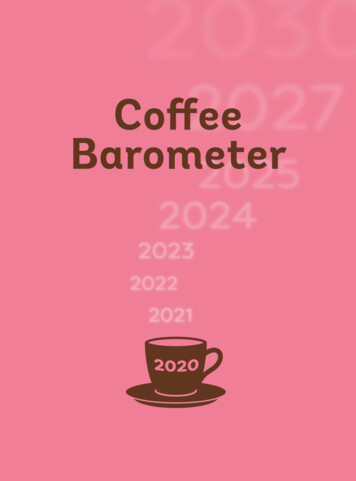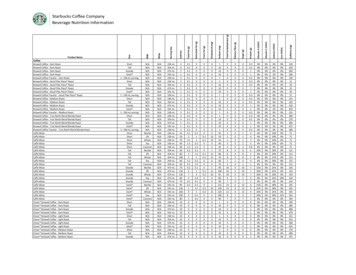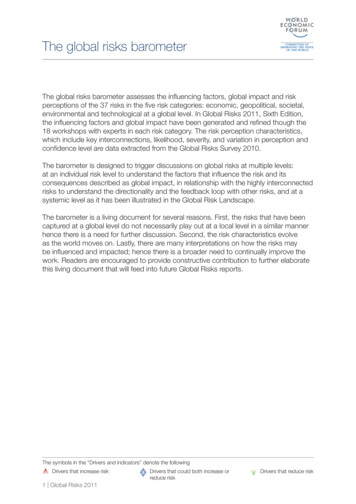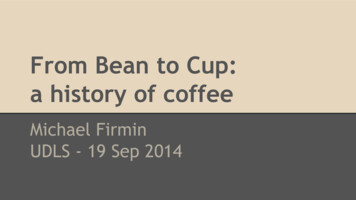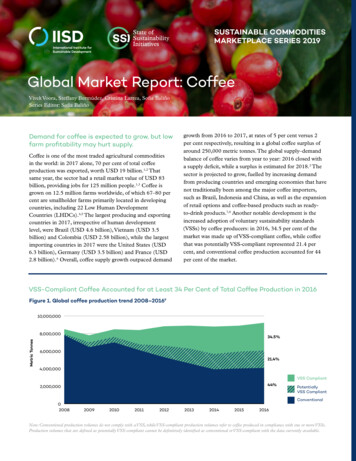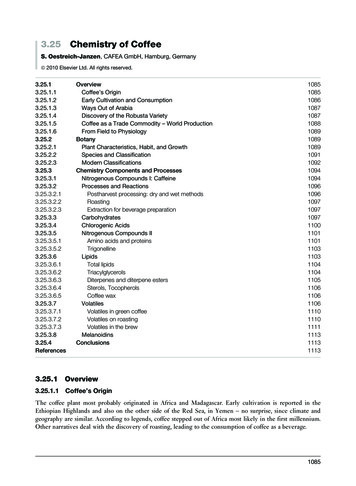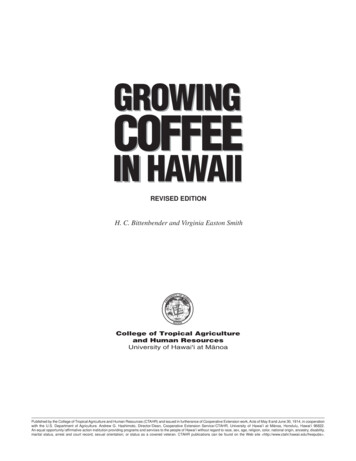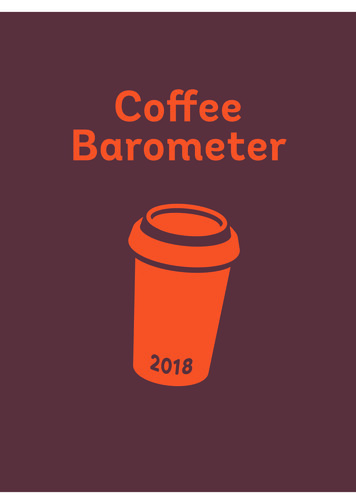
Transcription
CoffeeBarometer
Content1Introduction 32Market unrest 52.1 Roasters 52.2 Traders 82.3 Sustainability strategies 93Stress factors 103.1 Production and value distribution 103.2 Wages and labour 123.3 Climate change and deforestation 134Sustainability commitments 164.1 Investments in sustainability 164.2 Voluntary Sustainability Standards 174.3 Market demand 194.4 Sustainable Sourcing options 215Coffee sector collaboration 265.1 A global vision 265.2 Multi-Stakeholder Initiatives 276Conclusion 30Endnotes 33Sources 34Annex: Sustainable Sourcing 35Colophon 36
1 IntroductionToday’s coffee trends includepremiumisation, convenience,customisation, single-origin,and roast type. Consumersincreasingly appreciateinformation about certifiedsustainable and ethicallyproduced coffee.It is widely perceived that in the global value chain of coffee profits are made inindustrialised countries, at the expense of environmental and social problems in thecoffee producing countries. Coffee is a buyers-driven supply chain, where roasters,retailers and traders maintain a high level of opacity enabling them to capture most ofthe gains. In sharp contrast with the margins made by farmers in developing countries,the multinational food giants and investments funds in the USA and EU expect tocapitalise on growing demand in the coming decade. Billions are spent in countlessacquisitions and mergers, positioning famous coffee brands in new markets. As theglobal coffee industry consolidates, it cuts costs to optimise profits which causesadditional downward pressure in the value chain, which is increasingly felt by theproducers at the farm level.Trouble is brewing in the sector. A wide variety of complex and systemic issues-environmental, social and economic- jeopardises the future of coffee production.Price volatility, climate change and recurring outbreaks of pests and diseases threatena structurally increasing global supply of good quality coffee, while consumption andtherefore demand is expected to increase.In this new edition of the Coffee Barometer, we pinpoint some gaping holes in ourcollective knowledge that urgently need to be tackled. For example, coffee productionhas been growing by over 20% ( 26 million bags) since 2010, but we do not know howmuch forested land has been converted into farm land used for coffee production.1Furthermore, it is assumed that 20-25 million smallholder farmers produce 70% of thecoffee globally, an estimate that stands unchallenged in the last 15 years.2 The coffee3
harvest therefore depends on millions of farmworkers; an important but invisible groupof stakeholders. They remain largely voiceless in the discussions about a sustainablecoffee sector.To cope with such issues, stakeholders supporting a sustainable coffee sector havebeen at the forefront of shifting towards the procurement of certified and verified4coffee. Linking all stakeholders in the value chain with standards, training, certification,and seals of approval, the coffee sector is more advanced than any other commodity.Still, certification and verification systems appear unable to reach smallholderproducers in Africa and Asia, and drive market uptake in consuming countries.Increasing demand also yields an opportunity for positive change. The growth of thespecialty coffee sector leads to more direct sourcing initiatives. If executed properly,these can promote traceability and coffee quality, and provide a managed response tosome sustainability challenges.Moreover, there is growing support for non-competitive sector collaboration, blendingpublic and private investments to address fundamental sustainability challengesat an impactful scale. Such initiatives to bring about sector-wide change, like theGlobal Coffee Platform (GCP), the Sustainable Coffee Challenge (SCC) and nationalsustainability platforms, share many of the sector’s sustainability goals. However,steering collective investments in the coffee value chain towards the development andimplementation of solutions to sustainability issues, remains a difficult yet pressingchallenge.In this Coffee Barometer, we examine the recent boom of acquisitions and mergers,and track the main trends. We investigate the power relations embedded in the globalcoffee value chain, and the root cause of the main sustainability stress factors. In viewof these challenges, we will examine the sector’s strategies for change, and individualand collective efforts to create a truly sustainable coffee sector.
2 Market unrestThe global coffee industry isconsolidating, with countlessmergers and acquisitions inthe market. This could presentan opportunity to mainstreamsustainability efforts, but thereis little evidence that this ishappening within the newlyformed conglomerates.2.1RoastersTo the casual observer, the coffee market is highly diversified. In the streets thousandsof independent coffee bars exist alongside big retail chains such as Starbucks, CostaCoffee and Dunkin’ Donuts. In the supermarkets, the shelves are stacked with amplecoffee options. Beyond the traditional roast and ground products, shoppers can choosefrom a wide range of single-serve options, next to Italian espresso beans and low profileinstant coffee. Lining the refrigerated shelves of grocery stores are bottled or cannedReady to Drink Coffees (RTD), the fastest growing market segment.This wealth of choice veils the underlying structure of the global coffee industry, whichis in the mature stage of its life cycle. As growth stagnates among larger players, theyacquire smaller companies and diversify their portfolio to generate growth. Rapidconsolidation is transforming the global coffee industry from its roast and groundleaders, like Nestlé and Jacobs Douwe Egberts, to retailers, such as Starbucks andMcDonald’s. Beyond the traditional first wave roast and ground market, there is fiercecompetition at brand level in various market sub sectors, especially in the second andthird-wave coffee (Figure 1).After years of unrivalled market leadership, Nestlé’s global dominance of the coffeemarket is now being challenged by JAB Holding— a German investment firm owned bythe Reimann billionaire family. In the past six years, JAB Coffee (part of JAB Holdings)has been building a global coffee empire, investing over 50bn to acquire not only5
Figure 1: Main acquisitions and brands 2012-2018ueciqCarteNoiresoLSe Mer 'OrCar rvrtice ildL'O e NosirerMe rriE.ldS.ProximitéCaEspres20162014 2015inckzaKiaz* Lav coeseAltorgHinckKiewld Bron ColeemCha*ottleBrewldBlue BoCeleon tle Coffee *ksmauhrbotCSta cBlue BBest'stleatent Seense AgreemStarbucks Lice ItaliaazionTorrefNespressoJDEKeuLa rigvazzaNescafeDolce GustTasoteZoe r's ChoicgaeBonBu kaonBrdiasiliaNestléSmuckersStarbucksS t ra u ssUCCTcMa hibossimoZanet ti First Wave Second Wave* Third WaveNestlé’17 CseorHgPretAMangMondelez CoffeeGrand Mere - KencoBagelsstein BrotherBagels EinEnstein BrosFrieleFrielersrtsndee Egber BleeDouwtsaeoSensDE ManTeaoceeMocoff andCreL'Oou ffeoribCa t's C'Oroed eozPzuoPia ribCaeeoffCset'Pepple GroupKaffee Hag - Jacques Vabrerem rigMan gelo-Cafee D do P-Goonreeun M ghn toutoTusunlly'Cas C tainDieoffKr fé SdriceisheTimpy eletCoothffeKr igptowtsnentMn Cofsiaoufee Rnta* IntoasteinerslligBaress* Stum entsia Co Coffofptee* Bares own CoffefeeEspressoe Roaso CoffHouseeesters EspreJacobs - Tassimsso Houseo - GevaliaKeuLaPretAocrabispyKDr Pepper SnaKr-CpppeilaoDr Pe-G-POranginawleleto-OféS7UpSchweppesCanadian DrsCaainAu Bon PABP anyompe ad Cra BrPaneelsead Bagra Brer’s eePanefeggBru c Cofd zaueBal aciq erhaer'sCBegg BruCia wn upfee Oldto rgro FECofalzace AFcippBalorSu op CTeeooff gCosi meCniníshitekGraffe OOPnWléCoPeCtoweOldffeCooldrpeSu6JABTop ten roasters 35% of world’s coffee
consumer coffee brands but also restaurant chains that sell large volumes of coffee.JAB Coffee is a holding company, with companies and brands managed independentlyby its subsidiaries. JAB’s strategy is to buy into the most relevant sections of differentglobal markets while keeping the brands and varieties fairly separate. It has invested inpods and third-wave in the US, roast and ground in Europe, and instant coffee in Asia.3In January 2018, the JAB-owned coffee company Keurig Green Mountain acquired thesoftdrink company Dr. Pepper Snapple and named the merged entity KeurigDr. Pepper. While this might seem an unusual target for a company that has beenseeking deals to gain coffee market share against Nestlé, the acquisition fits in wellwith the strategy to transform coffee into a worthy soda alternative.4 This would makecoffee an all-day consumption option. Among the firms exploring this, are some of theworld’s largest soda brands: Pepsi makes Starbucks’ ready-to-drink coffees (RTD), andCoca-Cola owns Georgia, the biggest RTD coffee brand in the world. Recently, it startedexpanding RTD in Europe, along with announcing partnerships with Dunkin’ Donuts andMcDonald’s in the US.3The Swiss-based food giant Nestlé has identified coffee as one of its biggest growthopportunities. It seeks to establish itself firmly in the lucrative and increasinglycompetitive market for coffee specialties, by diversifying in terms of format, taste andprice point.5 Renowned for its global Nescafé and Nespresso brands, Nestlé surprisedthe coffee sector in May 2018 by joining forces with Starbucks to jointly innovate anddo market launches. This collaboration enables Nestlé to further gain market share inthe US – after recent third-wave acquisitions in the US - and extend its global lead overJAB. Nestlé’s 7.1bn deal includes the sale of Starbucks products through supermarkets,as well as developing Starbucks branded capsules for Nestlé’s single-serve brewers.6Next to the coffee giants Nestlé and JAB Coffee, there is no clear number three in theglobal coffee sector, as the fragmentation of markets in geographical regions and subsegments creates numerous and achievable paths to growth.3 The Lavazza Group couldtake this spot as the global number 3. It has a diverse portfolio of high-value brandsthroughout the roast and ground spectrum. Lavazza aims for transformation from apredominantly Italian company into a global brand capable to compete with Nestlé andJAB Coffee. Lavazza has been buying multiple brands in the EU and North America,including premium French coffee brand Carte Noire, trebling its turnover in Francewhich subsequently became its second largest market after Italy. Recently, Lavazzabranched out to North America, taking a majority stake in Kicking Horse, a Canadiancompany specialized in Fairtrade and organic certified coffee.7
Also worth highlighting is Starbucks, the leader in retail coffee who has ambitions toexpand globally. The chain added over 2,000 stores in 2016, bringing its global presenceto over 25,000 locations in 75 countries. This is only the start, since Starbucks isplanning to open 12,000 new stores globally. It is aiming to almost double its number ofcoffee shops in China, from 3,300 now, to 6,000 before the end of 2022.7 The companyalso develops 1000 premium Starbucks Reserve stores and roasters, a high-end line of8tasting rooms that will sit alongside the group’s existing global store concepts.2.2TradersRoasters rely heavily on coffee trading houses to obtain their supply of green coffee.Information about the exact extent of concentration in the coffee commodity tradesector is hard to find. The dominant companies are privately-held and therefore not tiedto any requirement to publicly share data and figures. This makes it hard to understandtheir true size and market influence. Still, it is obvious that the coffee trade industry ishighly concentrated. A limited number of trade houses source coffee globally. Industryleaders are Neumann Kaffee Gruppe, ED&F Man Volcafe and ECOM. The family-ownedNeumann group for instance, represents already the handling of 10% of the global greencoffee trade. Equalling 15 million bags in 2017, Neumann itself handles more than thetotal coffee production of Colombia in 2017!EC O MGNKVolcafeLDCSucafinaFigure 2: Top five green coffee tradersThe trade houses mainly deal in bulk grades and thin margins. They derive their incomesby dealing in very large volumes, usually supplying the largest multinational coffeeroasting companies.8 The smaller-sized international coffee trading companies oftenoperate in specialty and niche markets, such as fair-trade or direct trade. Tradinghouses not only own a large part of the processing and storage facilities in most coffeeproducing countries, they also engage in farm management, export and import of bulk,specialty and instant coffee, logistics, storage, risk management and finance. Thecommodity trading houses are either vertically integrated in the coffee supply chainor they can use hedging instruments to manage the risk of price volatility. Neumann
Kaffee Gruppe and ED&F Man Volcafe have their own in-house options and futuresbrokerages (respectively TRX Futures and ED&F Man Commodity Advisors Limited).Smaller traders, particularly those dealing in specialty grades of coffee, either do nothedge or will hedge only a proportion of their traded volume. The main reason for thisdifference in hedging practices is the difference in the process of coffee trading andpricing for the bulk grades, compared to the specialty grades.89In recent years, all trading houses strengthened their local presence and supplynetworks to stimulate sustainably produced coffee in the countries of origin. As thecoffee industry consolidates, new services are required, including trade finance andrelated services. Based on their increased size and growing market influence, JABCoffee now asks traders terms of payment ranging up to 300 days. This is a prefinancing about three times as long as Nestlé typically demands.9 Only the very largetraders can provide such extensive financing. Increasing competition may lead to aconcentration of traders, that can carry the risks of longer payment terms. Peakinginterest rates or a sudden spike in futures prices could leave traders with losses orstretch their financing needs as hedging costs go up. It also leaves them with less fundsto invest in farmers’ training programmes. Despite its deep pockets, JAB Coffee can beconfronted with banks that pull or tighten its credit lines in case its financial standingdeteriorates.2.3Sustainability strategiesCompletion of mergers and acquisitions and integration of new businesses areusually multi-year processes. This can lead to loss of focus on the development andimplementation of sustainability commitments. The competitiveness at the roasterand retail level does not seem to value sustainability as a differentiator. The companiesinstead are trying to build families of specialty-brands that appeal to high-endconsumers. In the race to position the brands individually, there does not seem to be aconcerted effort among roasters to align or strengthen sustainability commitments atbrand level, let alone at holding level.Consolidation might yield an opportunity for a joint effort from different brands, if thebrand owners truly make sustainability part of their ethos. If they use their scale tocollaborate and develop ambitious and overarching sustainability strategies, this wouldcreate a strong force for positive change. Up to now however, quite the contrary seemsto be happening. Apparently the manifold of recent mergers have a paralysing effecton the individual companies’ sustainability agendas, and hence on the coffee sector atlarge. Besides the various CSR-activities of different companies, the real question isto what extent sustainable transformation and systemic change-thinking are part ofcompanies’ proactive sustainability strategies.See page 22; summary of company’s sustainability policies and practices.
3 Stress factorsA sustainable coffee sector moreequally distributes proceeds tofarmers. Currently the averagegreen coffee export value is lessthan 10% of the 200 billionrevenues generated in the coffeeretail market. This imbalanceillustrates the pressing need fortransparency of transactions inorder to achieve re-distribution.103.1Production and value distributionIn the period 2012 - 2017, coffee consumption and production increased by an averageof 2% per year. Consumption levels are rising outside the traditional EU and USAmarkets, especially in Southeast Asia. If this pace of growth continues, the coffee sectorwill need 300 million bags of coffee by 2050, which means doubling or even tripling thecurrent annual world production.10/11 The current system of coffee production will not beable to meet the increasing demand in the coming decades. The minimum gap will be60 million bags (a deficit higher than Brazil’s current annual production), and withoutmajor efforts to adapt coffee production to climate change, global production couldeven be lower in 2050 than it is today.10In crop year 2016/17, coffee farmers produced a record crop of almost 160 million60-kg bags.12 Arabica and Robusta are the two main types of coffee. A high proportionof Arabica coffee is grown in Brazil, Colombia and Ethiopia (Figure 3). Arabica beansyield higher market prices compared to Robusta, which is grown in humid areas at lowaltitudes in Vietnam, Indonesia and Uganda. Compared to Arabica, Robusta is moreresistant to diseases and the yield per tree is considerably higher. Robusta yields roughlyone-third more beans per hectare than Arabica. Over the last decade, productionof Robusta increased significantly to a level up to 40% of world production. Robustaproduction is likely to rise as global warming makes more land suitable for this variety,and less favourable for growing Arabica beans.13
Figure 3 Top ten coffee producing countriesArabica vs RobustaTotal HondurasEthiopiaMexicoGuatemalaAround 75% of the total global production of Arabica and Robusta is exported,generating producing countries a total value of 16 billion in 2016.14 Taking volatilityof annual prices and volumes into account, the average annual export value is 20.2 billion in the period 2010-2015. This figure comprises the income of farmers,exporters and government agencies involved in growing the beans and exporting theminternationally. A shocking statistic is the fact that this figure represents only 10% ofthe total industry value, which was estimated in 2015 at around US 200 billion. Only10% of the aggregate wealth of coffee stays in the producing countries.15Obviously, constrained supply of high quality Arabica coffee, combined with increasingdemand, should lead to increasing prices. But this has not been the case. Lower-gradeArabica can be substituted with Robusta in coffee blends. This reduces the roaster’scost levels, and goes unnoticed, since most coffee consumers lack the sensory skillsto recognize high quality coffee. They are therefore more likely to rely on external cues,such as price, packaging and advertising, that may or may not reflect the intrinsicquality of the product.16 A survey of ground roast coffee samples labelled as 100%Arabica found that 10% contained significant levels of Robusta coffee.17World coffee prices have fallen by two-thirds in real terms since the early 1980s, andthe real earnings of coffee farmers have halved in that time.18 Farmers earning toolittle to secure decent living conditions, won’t invest in their farms. Earnings can vary11
widely, due to inefficiencies in the supply chain. Farmers in Latin America can receiveup to 87% of the export price, whereas this in East Africa this could be as low as 61%due to variations in farmer organizations, policy environment and competitive markets.The answer to the question if making a decent living income is actually feasible in thecurrent coffee market, strongly depends on the local context.For a sound picture of value distribution along the coffee chain, insight is needed in12earnings as well as costs of production at the various links of the supply chain. Recordkeeping at farm level is required, as well as a need for the companies in the chain to betransparent about their costs. (Box 1. Example of true pricing)Box 1: True PricingThe costs of environmental and social externalities to produce coffee are often overlooked. Truepricing incorporates burdens to society, such as soil and water pollution, farmers and workerssocial security and a decent wage level, in the total costs of coffee. This methodology is basedon an approach driven by a cost-benefit equation, rather than on compliance. This should inturn improve the effectiveness of investments in sustainability. An example from research inMexico estimates the true price of conventional coffee at 11.10, while the market price is only 3.30. If we compare this to climate-smart coffee (CSA), its true price is estimated around 3.90, while the market price of this CSA-coffee is around 2.90. This research concludesthat investments in climate-smart coffee have a higher return on investment. Thanks to yieldincreases, but also to environmental gains in natural capital and higher carbon sequestration.This is both cost-effective and profitable, although support to farmers to make this transitionis required. Incorporation of external costs and benefits allows for benchmarking differentproduction systems, and it lowers the bar to decide to investment in coffee produced withlower external costs.193.2Wages and labourLow prices, excessive volatility and low yields not only affect farmers’ income,it also reduces interest of farmers and future generations to engage withcoffee farming, and it causes labour shortages during harvest time.When coffee commodity prices are low, while global competition is intense, producersare under constant pressure to cut costs, including those relating to labour. Thereview of farm profitability in four major coffee producing countries by the ICO in 2016confirms that coffee farmers have often been operating at a loss between 2006 and2016, and that coffee does not provide a viable livelihood.20 This leads to a negativespiral as subsequently there is no or little funding for investment in good agriculturalpractices and farm sustainability, resulting in decreasing quality and yields, meaninglower income and the cycle continues. Despite mechanisation efforts in a few producingcountries, coffee production is highly labour intensive, involving a large and diversework force. Labour is the biggest component in the total cost of coffee production. The
estimates of the total number of farmers and farmworkers varies (Box 2), besides theobvious reason - the data in many coffee-producing countries is unreliable - there areother factors that play a role:- To many smallholder producers, coffee is no longer their main business or income.They switch to other crops or play multiple roles to supplement their income;- In countries where economic development creates opportunities for higher-payingemployment, many male farmers migrate to urban areas or abroad. The farm isoften left to their spouses and children, who are not registered as coffee farmers;- Coffee is considered a men’s crop. Whereas women often play a pivotal role inmuch of the production activities, they tend to remain an invisible work force. Theyearn less income, own less land, are less organised and have fewer training andleadership opportunities;- There is a tendency among farmers to stop growing coffee due to decreasedincome per smallholder farm unit, due to a combination of low market prices, lowerproductivity, higher labour costs and pests and diseases;- To many young farmers coffee equals a poverty crop with no future. Access toeducation provides opportunities for employment outside the coffee sector.Box 2: Coffee farmer populationThe coffee sector lacks a deep understanding of farmers and workers. Where they come from,what their working conditions are, and how much they earn. Better data are direly needed onthe figure of 20-25 million smallholder coffee farmers and the vaguely defined 100 millionpeople in the producing and processing of green coffee. As global data on the number and sizeof coffee farms is not conclusive, accurate data on the number of farmers and (seasonal) farmworkers is even harder to find. A detailed study and statistical modelling of farmer productiondynamics across 20 major coffee origins is now taking place. This will provide new information,including a revised global estimate of the total coffee farmer population, as well as insights intofarm size and yield distributions within the countries included.213.3Climate change and deforestationGiven the changes in climate, it is paramount the coffee sector encouragesan integrated coffee production system with lower environmental impactat landscape level, to meet both economic and environmental goals whilecreating resilience to current and future climate change.In the equatorial belt where coffee cultivation takes place, climate change issignificantly impacting yields and quality. The combination of higher temperatures,prolonged droughts, and heavy rains and frosts influence coffee production in manyways: from decreasing areas suitable for growing coffee to increasing pressure frompests and diseases.22 For instance, the coffee berry borer and roya, the coffee rustdisease that struck farmers in Central America, Colombia and Peru. Countries like13
Brazil, India and Uganda are predicted to lose more than 60% of their suitable coffeeareas by 2050, and even the countries expected to see the least losses - like Colombiaand Ethiopia - are predicted to lose up to 30% of their land fit for coffee cultivation.13At the same time new crop land is created for coffee production. This leads to additionalenvironmental concerns, especially when coffee cultivation reaches more remote14areas. Deforestation is of particular concern when it comes to land-transformationwithin coffee growing regions. Given that many coffee lands are home to some of theworld’s most delicate ecosystems, expanding coffee cultivation threatens irreplaceablehabitats of particularly high biodiversity value and may damage critical ecosystemfunctions. The total area dedicated to coffee production is estimated by FAOSTAT atsome 10,5 million hectares. FAOSTAT figures show a decline compared to a decade ago,even though during this period global production has increased substantially.It is therefore likely that the national reporting of total coffee land area is inaccurateand that the total land-flux of coffee (estimated area entering and leaving coffeeproduction) is rising due to abandonment of coffee production at low altitudes dueto global warming, and converting new land to coffee crop land to supply increasingdemand.1/23Efforts to meet the growing demand for coffee, could by 2050 potentially causedoubling – and perhaps even tripling – the current 10,5 million hectares of land usedfor coffee production.10/11 However, 60% of the land suitable for coffee production in2050 is currently forested. In addition, only 20% of this is under any formal protection.Meeting future demand for coffee could come at the expense of forests.11 Data oncoffee land use change suggests that apart from Brazil, where increases in productionare driven by technology, in nearly all countries where coffee production is expandingrapidly – e.g. Vietnam, Indonesia, Ethiopia and Peru- new coffee crop lands are mostlycreated by deforestation. Forests are converted into lightly shaded or full-sun coffeeproduction systems with few or no trees. The annual increase is likely to be well over100,000 ha equalling an area of 548 (!) football pitches deforestated per day. The exactfigure is impossible to assess, because data is inaccurate or lacking.1/24This transformation is driven by the perceived higher economic performance ofintensified systems, aiming at increasing short-term income. The idea to intensifycoffee production started in the 1970s and has become the dominant model: itpromotes to reduce or eliminate shade trees, plant high densities of new coffee varietiesin a monoculture and add synthetic fertilisers and pesticides.25 Consequently, a largeshare of coffee production area worldwide is being managed without shade, and onlyless than a quarter of coffee plantations has multi-layered, diversified shade.26/27Revitalising of shade management in a coffee agroforestry system can provide amultitude of environmental services, including carbon sequestration, watershedprotection, and biodiversity conservation.25 While sun-grown systems can have higheryields, profitability and cost-efficiency are higher for small-scale shaded systems.The long-term value of trees, the lower costs per area and higher price per kilogram ofcoffee make a clear business case for promoting integrated farm management.28
Forest conservation in combination with coffee agroforestry can reconcile economicand environmental goals. Since coffee is a perennial plant that lasts for 20 to 30years, this is about long-term planning and investing. However, as smallholder coffeefarmers are struggling to survive due to small farms plots and low productivity, ashort-term approach often prevails. For instance, structural renovation (replanting)and rehabilitation (heavy pruning) of coffee farms is crucial to increase and maintainproductivity levels. A new industry guidebook highlights that globally 4 million hectaresof smallholder coffee lands are in need of renovation and rehabilitation (R&R), which isthe equivalent to the entire harvested area of Brazil, Vietnam, Colombia and Ethiopia.29Economical issuesSocial issuesOverview of the social, economic and environmentalissues at the producer level41Smallholder levelEstate levelFood insecurityMalnutritionPoor access to education and healthcareGender inequalityAgeing farmer communitiesMigration & young people leaving coffee farm
coffee shops in China, from 3,300 now, to 6,000 before the end of 2022.7 The company also develops 1000 premium Starbucks Reserve stores and roasters, a high-end line of tasting rooms that will sit alongside the group’s existing global store concepts. 2.2 Traders Roasters rely heavily on coffee
